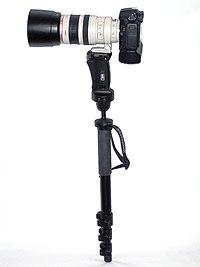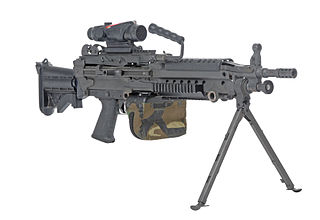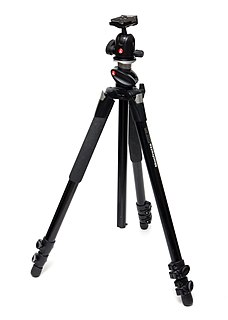This article needs additional citations for verification .(February 2016) |


A monopod, also called a unipod, is a single staff or pole used to help support cameras, binoculars, rifles or other precision instruments in the field.
This article needs additional citations for verification .(February 2016) |


A monopod, also called a unipod, is a single staff or pole used to help support cameras, binoculars, rifles or other precision instruments in the field.
The monopod allows a still camera to be held steadier, allowing the photographer to take sharp pictures at slower shutter speeds, and/or with longer focal length lenses. In the case of video, it reduces camera shake, and therefore most of the resulting small random movements. Monopods are easier to transport and quicker to set up than conventional tripods, making them preferable for on-the-go (OTG) photography. [1] An OTG photographer is not able to carry a heavy, bulky tripod around, and when they see a potential shot, there is no time to bother with setting up a complicated tripod. A simple monopod is easy to carry, easy to set up, and enables the photographer to take advantage of the situation they are presented with, all while providing camera support to capture a clear, sharp image. [1] Examples of situations in which a monopod is preferable include wildlife and sports photography where you can dramatically increase the stability of long lenses, travel photography, particularly around the golden hours and of course outdoor macro photography, especially when trying to photograph insects etc. [2]
When used by itself, it eliminates camera shake in the vertical axis. When used in combination with leaning against a large object, a bipod is formed; this can also eliminate horizontal motion.
Unlike a tripod, monopods cannot support a camera independently. In the case of still cameras, this limits the shutter speed that can be used. They still allow longer exposures than hand holding, and are easier to carry and use than a tripod. Because it confers less stability than a tripod, monopods may present difficulties when trying to get a good image with very low light photography, i.e. night time, and shots where you need a 100% stable camera for example shooting light trails or landscapes with extreme depth of field. [2]
Many monopods can also be used as a "beltpod," meaning that the foot of the monopod can rest on the belt or hip of the photographer. This is usually used in selfies for clearer shots by ensuring that the camera is not in motion relative to the body. [3]
With a special adapter, monopods can be used as a "chestpod", meaning that the foot rests now on the chest of the photographer. The result is that the camera is held more steadily than by hand alone (though not as steadily as when the foot is planted on the ground), and the camera/monopod is completely mobile, travelling with the photographer's movements. This technique is widely used in videography in which the photographer has to move with the subject [1] e.g. first-person scenes, and is also especially useful for disabled photographers.
Generally, in terms of mobility versus stability, if mobility increases, stability decreases as follows:
Monopods are often equipped with a ball swivel, allowing some freedom to pan and tilt the camera while the monopod remains relatively stationary.
Walking sticks or "trekking poles" exist that have a 1/4"-20 threaded stud on the top of the handle, usually covered by a cap when not in use, allowing them to double as a camera monopod. The user would usually need to carry a ball swivel adapter separately and mount it as needed.
Monopods used with a smartphone or camera to take selfie photographs beyond the normal reach of the arm are known as selfie sticks, and (depending on the model) may have Bluetooth connectivity. [4]
There are two ways to attach your camera to a monopod. The first is to screw the monopod's screw thread directly into the camera body. This is fine if you're using a fairly small, light lens.
If you're shooting using a long, heavy telephoto lens, it's better to use a tripod mount ring. This fixes the monopod to the lens rather than the camera body, giving better balance and stopping the monopod from rotating in your hands as you try to position it.
There are various different types of monopod head available, and ball heads offer the most flexibility. They allow you to shoot in portrait or landscape orientation, and angle your camera to adjust for any sloping of the monopod. [5]

A monopod can be used for firearms. They have the advantage of being light and compact, although when used in firing mode they can only be used with small firearms. They are also used as "butt spikes" as a rear support on precision rifles.
When used to support a compass or transit, the monopod is referred to as a jacob staff . [6] Mounting the compass atop the jacob staff eliminates reading errors introduced by body movements, and permits the taking of more precise bearings to targets. [7]
Monopods known as finnsticks are also used to steady high-power (typically, 10× or more) binoculars to permit a clear view without shake or wobble introduced by the user's hand and body movements. With the introduction of gyroscopically stabilized binoculars, the use of stabilizing supports for binoculars have declined in recent years.

A view camera is a large-format camera in which the lens forms an inverted image on a ground-glass screen directly at the film plane. The image is viewed and then the glass screen is replaced with the film, and thus the film is exposed to exactly the same image as was seen on the screen.

In photography, shutter speed or exposure time is the length of time that the film or digital sensor inside the camera is exposed to light when taking a photograph. The amount of light that reaches the film or image sensor is proportional to the exposure time. 1⁄500 of a second will let half as much light in as 1⁄250.

A tripod is a portable three-legged frame or stand, used as a platform for supporting the weight and maintaining the stability of some other object. The three-legged design provides good stability against gravitational loads as well as horizontal shear forces, and better leverage for resisting tipping over due to lateral forces can be achieved by spreading the legs away from the vertical centre.

A spotting scope is a compact high-power telescope optimized for detailed observation of distant objects. They are used as portable optical enhancement devices for various outdoor activities such as birdwatching, skygazing and other naturalist activities, for hunting and target shooting to verify a marksman's shot placements, for tactical ranging and surveillance, and for any other application that requires higher magnification than ordinary binoculars.

A monocular is a compact refracting telescope used to magnify images of distant objects, typically using an optical prism to ensure an erect image, instead of using relay lenses like most telescopic sights. The volume and weight of a monocular are typically less than half of a pair of binoculars with similar optical properties, making it more portable and also less expensive. This is because binoculars are essentially a pair of monoculars packed together — one for each eye. As a result, monoculars only produce two-dimensional images, while binoculars can use two parallaxed images to produce binocular vision, which allows stereopsis and depth perception.

The EF lens mount is the standard lens mount on the Canon EOS family of SLR film and digital cameras. EF stands for "Electro-Focus": automatic focusing on EF lenses is handled by a dedicated electric motor built into the lens. Mechanically, it is a bayonet-style mount, and all communication between camera and lens takes place through electrical contacts; there are no mechanical levers or plungers. The mount was first introduced in 1987.

Image-stabilized binoculars are binoculars that have a mechanism for decreasing the apparent motion of the view due to binocular movement. Such binoculars are designed to minimize image shaking in hand-held applications. Higher-power binoculars magnify the image more, but the image shift is also increased. This means that even minor hand movements can cause huge image shifts. Image stabilization technology in binoculars ensures instant adjustment of the image to compensate for the motion. Major brands making image stabilized binoculars include Canon, Fujinon, Nikon, Carl Zeiss, and Bushnell.

A bipod is a V-shaped portable attachment that helps support and steady a device, usually a weapon such as a long gun or a mortar. The term comes from the Latin prefix bi- and Greek root pod, meaning "two" and "foot" respectively.
A finnstick is the name given by birdwatchers to a stick used to support a binoculars. The one end of the stick is steadily attached to the binocular while the other end rests against the belly.

In photography, a tripod is a portable device used to support, stabilize and elevate a camera, a flash unit, or other videographic or observational/measuring equipment. All photographic tripods have three legs and a mounting head to couple with a camera. The mounting head usually includes a thumbscrew that mates to a female-threaded receptacle on the camera, as well as a mechanism to be able to rotate and tilt the camera when it is mounted on the tripod. Tripod legs are usually made to telescope, in order to save space when not in use. Tripods are usually made from aluminum, carbon fiber, steel, wood or plastic.

Image stabilization (IS) is a family of techniques that reduce blurring associated with the motion of a camera or other imaging device during exposure.

In cinematography and photography panning means swivelling a still or video camera horizontally from a fixed position. This motion is similar to the motion of a person when they turn their head on their neck from left to right. In the resulting image, the view seems to "pass by" the spectator as new material appears on one side of the screen and exits from the other, although perspective lines reveal that the entire image is seen from a fixed point of view.
The following outline is provided as an overview of and topical guide to photography:

Sports photography refers to the genre of photography that covers all types of sports.

Fireworks photography is the process of taking photographs of fireworks at night. It is a type of night photography, specifically using available light of the fireworks instead of artificial light. Without using the flash on the camera, the photographer often exposes the image for a period of time, known as long exposure. Brighter fireworks sometimes support shorter exposure times.

Mobile accessories include any hardware that is not integral to the operation of a mobile smartphone as designed by the manufacturer.

Landscape photography shows the spaces within the world, sometimes vast and unending, but other times microscopic. Landscape photographs typically capture the presence of nature but can also focus on man-made features or disturbances of landscapes. Landscape photography is done for a variety of reasons. Perhaps the most common is to recall a personal observation or experience while in the outdoors, especially when traveling. Others pursue it particularly as an outdoor lifestyle, to be involved with nature and the elements, some as an escape from the artificial world.
A weapon mount is an assembly or mechanism used to hold a weapon onto a platform in order for it to function at maximum capacity. Weapon mounts can be broken down into two categories: static mounts and non-static mounts.

A tripod head is the part of a tripod system that attaches the supported device to the tripod legs, and allows the orientation of the device to be manipulated or locked down. Modular or stand-alone tripod heads can be used on a wide range of tripods, allowing the user to choose which type of head best suits their needs. Integrated heads are built directly onto the tripod legs, reducing the cost of the tripod system.

A camera stabilizer, or camera–stabilizing mount, is a device designed to hold a camera in a manner that prevents or compensates for unwanted camera movement, such as "camera shake".